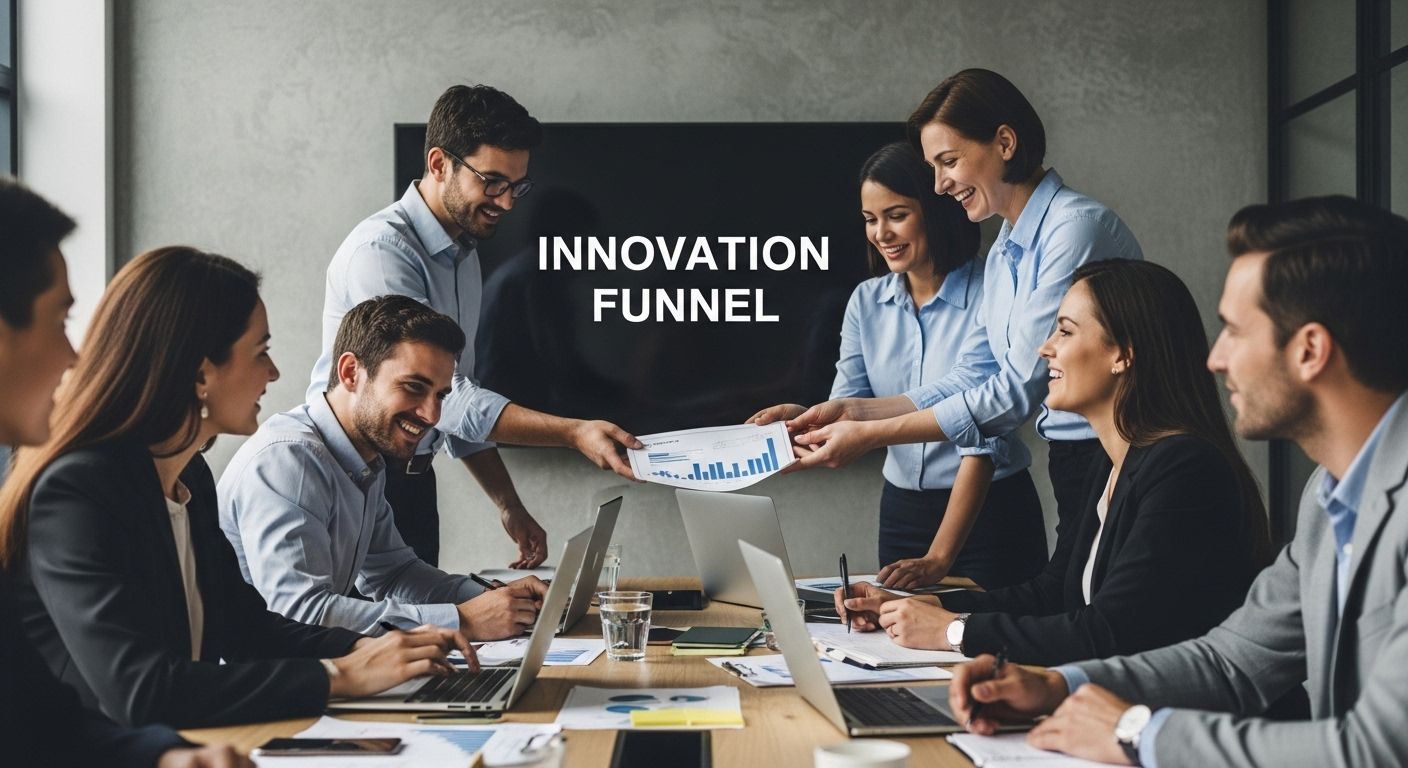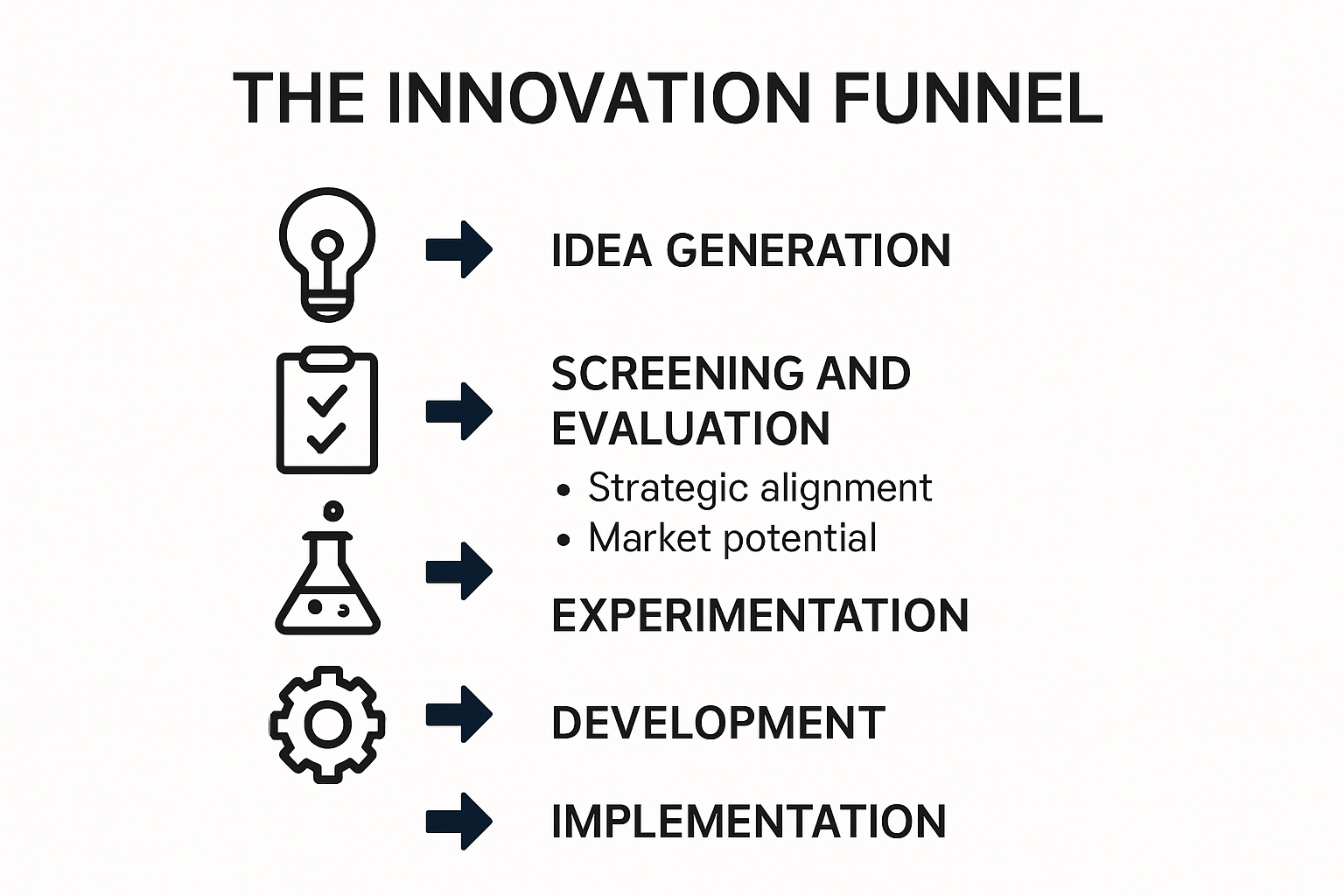


What is Innovation Funnel? A Guide for Leaders
Every company wants to launch the next big thing, but most ideas never make it past the drawing board. Surprisingly, only about 1 in every 3,000 raw ideas ever becomes a successful product. Most leaders think it all comes down to creativity or luck. The real difference is a structured innovation funnel that quietly turns scattered ideas into the winning solutions that drive real business growth.
Table of Contents
- Defining The Innovation Funnel Process
- Key Stages Of The Innovation Funnel Explained
- Best Practices For Managing An Innovation Funnel
- How Innovation Funnels Drive Organizational Success
Quick Summary
| Takeaway | Explanation |
|---|---|
| Use a structured approach to innovation | Implementing an innovation funnel provides a systematic way to develop and evaluate ideas effectively. |
| Evaluate ideas through strategic filtering | Assess concepts based on market potential, organizational alignment, and resource requirements to prioritize high-value innovations. |
| Foster a culture of creativity and safety | Encourage psychological safety and recognition to motivate employees in sharing innovative ideas without fear of failure. |
| Implement a stage-gate process | This structured methodology allows organizations to assess ideas at each stage, ensuring a disciplined approach to innovation. |
| Continuously refine the innovation process | Adapt your strategies and frameworks regularly to keep pace with market changes and maintain organizational agility. |
Defining the Innovation Funnel Process
The innovation funnel represents a strategic framework that transforms raw ideas into actionable business solutions through a systematic progression of stages. Organizations use this methodical approach to filter and refine potential innovations, ensuring only the most promising concepts receive resources and attention.
The Structured Journey of Innovation
At its core, the innovation funnel is a deliberate process of idea management that guides concepts from initial conception to potential market implementation. Learn more about managing your innovation pipeline by understanding its key stages.
To help leaders understand the structured journey of innovation, here is a table summarizing the five key stages of the innovation funnel along with their main objectives:
| Innovation Stage | Main Objective |
|---|---|
| Idea Generation | Generate creative and breakthrough concepts |
| Screening and Evaluation | Assess ideas for strategic alignment and potential value |
| Experimentation | Test and validate the feasibility and market potential of selected ideas |
| Development | Turn validated concepts into prototypes or concrete solutions |
| Implementation | Launch innovations to market or integrate them within organizational systems |
According to MIT Sloan Management Review, the innovation funnel typically encompasses five critical stages:
- Idea Generation: The initial phase where creative thinking and problem-solving converge to produce potential breakthrough concepts
- Screening and Evaluation: A rigorous assessment process that determines which ideas have strategic alignment and potential value
- Experimentation: Practical testing of ideas to validate their feasibility and market potential
- Development: Transforming validated concepts into concrete prototypes or solutions
- Implementation: Bringing refined innovations to market or integrating them within organizational processes
Strategic Filtering and Evaluation
The innovation funnel operates on a principle of progressive narrowing. As Open University’s Technology Management research explains, each stage introduces increasingly stringent criteria that separate promising innovations from concepts that lack strategic merit.
This filtering mechanism serves multiple critical functions. It prevents resource wastage by concentrating organizational energy on high-potential ideas. Moreover, it creates a structured pathway that transforms creative thinking into actionable strategic initiatives. Leaders can systematically assess ideas based on multiple dimensions such as:
Below is a process table that organizes the main screening and evaluation criteria mentioned, which leaders can use to effectively filter and prioritize innovation ideas:
| Screening Criteria | Purpose |
|---|---|
| Market Potential | Assess revenue opportunity and ability to solve customer needs |
| Organizational Alignment | Ensure idea supports existing strategic goals and capabilities |
| Resource Requirements | Estimate investment and resource needs for development |
| Competitive Advantage | Determine the ability to differentiate from competitors |
| Technical Feasibility | Evaluate how practical the idea is for implementation |
- Market Potential: Likelihood of generating revenue or solving significant customer challenges
- Organizational Alignment: Compatibility with existing strategic goals and capabilities
- Resource Requirements: Estimated investment needed for full development and implementation
- Competitive Advantage: Potential to differentiate the organization in its market segment
The innovation funnel is not a linear, rigid process but a dynamic framework that allows for iterative refinement. Organizations must remain flexible, recognizing that breakthrough innovations often emerge through unexpected pathways. Strategic adaptability becomes as crucial as the structured evaluation process itself.
Effective innovation management requires leaders to view the funnel as more than a mechanical filtering system. It is a living ecosystem of creativity, strategic thinking, and calculated risk-taking. By embracing this comprehensive approach, organizations can systematically cultivate a culture of continuous innovation that drives long-term competitive advantage.
Key Stages of the Innovation Funnel Explained
The innovation funnel is a sophisticated process that transforms abstract ideas into tangible business solutions through carefully orchestrated stages. Each stage represents a critical checkpoint where ideas are evaluated, refined, and potentially advanced or eliminated.

Comprehensive Idea Generation and Mobilization
The first stage of the innovation funnel focuses on creating a robust environment for idea generation. According to National Academies Press, successful innovation begins with an awareness phase where potential solutions are first observed and explored. Organizations must create open channels that encourage employees, customers, and stakeholders to contribute innovative concepts.
Key strategies for effective idea generation include:
- Collaborative Platforms: Creating spaces where cross-functional teams can share and develop ideas
- External Engagement: Soliciting input from customers, partners, and industry experts
- Structured Brainstorming: Implementing systematic approaches to creative problem-solving
Explore advanced techniques for innovation management to maximize your idea generation potential.
Rigorous Screening and Evaluation Process
Once ideas are generated, the innovation funnel enters a critical screening phase. Open University’s Technology Management research highlights the importance of a systematic approach to evaluating potential innovations.
This stage involves a comprehensive assessment based on multiple criteria:
- Strategic Alignment: Ensuring ideas match organizational goals
- Market Potential: Analyzing potential economic impact and customer value
- Technical Feasibility: Evaluating the practical implementation of the concept
- Resource Requirements: Assessing the investment needed for development
Experimentation and Implementation
The final stages of the innovation funnel transform promising ideas into actionable solutions. According to MIT Sloan Management Review, this involves a structured process of experimentation, development, and ultimately, implementation.
Successful implementation requires:
- Prototype Development: Creating initial versions of the innovative solution
- Market Testing: Conducting controlled trials to validate concept viability
- Scalability Assessment: Determining the potential for broader organizational adoption
Leaders must approach the innovation funnel as a dynamic, iterative process. It is not a linear progression but a flexible framework that allows for continuous refinement. The most successful organizations view innovation as an ecosystem that nurtures creativity while maintaining strategic discipline.
Ultimately, the innovation funnel is more than a methodological approach—it is a strategic tool that enables organizations to systematically transform creative potential into competitive advantage. By understanding and effectively managing each stage, leaders can create a sustainable innovation pipeline that drives long-term organizational growth and adaptation.
Best Practices for Managing an Innovation Funnel
Managing an innovation funnel requires a strategic and disciplined approach that balances creativity with systematic evaluation. Leaders must develop robust frameworks that enable continuous innovation while maintaining organizational alignment and resource efficiency.
Establishing a Robust Governance Framework
Learn about optimizing your innovation management strategies to create a comprehensive governance approach. According to the National Academies Press, effective innovation management begins with a structured portfolio approach that defines clear processes for idea assessment and advancement.
Key elements of a strong governance framework include:
- Clear Decision-Making Protocols: Establishing transparent criteria for evaluating and selecting innovative ideas
- Cross-Functional Collaboration: Creating teams that represent diverse perspectives and expertise
- Regular Review Mechanisms: Implementing periodic assessments to track progress and realign strategies
Implementing a Stage-Gate Innovation Process
The stage-gate process provides a structured methodology for managing the innovation funnel. Research from the Administration for Children and Families emphasizes the importance of breaking down the innovation journey into distinct, measurable stages.
Critical components of an effective stage-gate process include:
- Defined Entry and Exit Criteria: Clear benchmarks for progressing ideas through each stage
- Continuous Performance Monitoring: Tracking key performance indicators at each innovation stage
- Flexible Resource Allocation: Dynamically adjusting resources based on project potential
Cultivating an Innovation-Supportive Culture
Explore advanced portfolio management techniques to enhance organizational innovation capabilities. The National Center for Biotechnology Information highlights that successful innovation management extends beyond processes to encompass organizational culture.
Strategies for building an innovation-supportive environment include:
- Psychological Safety: Creating an atmosphere where employees feel comfortable sharing and exploring new ideas
- Reward and Recognition Systems: Developing mechanisms that incentivize innovative thinking
- Continuous Learning: Promoting a culture of experimentation and knowledge sharing
Successful innovation funnel management requires a holistic approach that combines structured processes with a flexible, supportive organizational environment. Leaders must remain committed to creating systems that not only generate innovative ideas but also effectively transform them into tangible business value.
By implementing these best practices, organizations can develop a repeatable and scalable approach to innovation. The key lies in balancing systematic evaluation with the creative freedom necessary for breakthrough thinking. Innovation is not a destination but a continuous journey of exploration, learning, and strategic adaptation.
How Innovation Funnels Drive Organizational Success
Innovation funnels represent more than a theoretical concept—they are powerful strategic tools that enable organizations to transform creative potential into sustainable competitive advantages. By systematically channeling ideas through a structured process, companies can dramatically enhance their capacity for breakthrough development and organizational resilience.
Strategic Alignment and Resource Optimization
Explore strategies for maximizing innovation potential and understand how innovation funnels create strategic value. According to research from the National Science Foundation’s Engineering Research Centers, successful organizations implement three critical pillars: Channeled Curiosity, Boundary-Breaking Collaboration, and Orchestrated Commercialization.
Key benefits of strategic innovation funnel management include:
- Focused Resource Allocation: Directing investments toward high-potential initiatives
- Risk Mitigation: Systematically evaluating and filtering potential innovations
- Organizational Alignment: Ensuring innovation efforts support broader strategic objectives
Accelerating Technology Transfer and Commercialization
The innovation funnel serves as a critical mechanism for transforming conceptual ideas into marketable solutions. Research from ExxonMobil Chemical Company demonstrates how a structured innovation process can significantly reduce the time between basic research and commercial implementation.
Critical components of accelerated technology transfer include:
- Rapid Prototyping: Quickly developing and testing innovative concepts
- Cross-Functional Collaboration: Integrating expertise from multiple organizational domains
- Scalable Implementation Strategies: Creating frameworks for broader organizational adoption
Fostering a Culture of Continuous Innovation
Discover additional innovation management resources that can transform organizational capabilities. Massachusetts General Hospital’s innovative approach illustrates how open innovation challenges can engage broader organizational participation and drive meaningful change.
Strategies for cultivating an innovation-driven culture include:
- Transparent Evaluation Processes: Creating clear, accessible innovation assessment mechanisms
- Recognition and Incentive Programs: Rewarding creative thinking and breakthrough contributions
- Psychological Safety: Encouraging risk-taking and learning from potential failures
Successful organizations recognize that innovation is not a destination but a continuous journey. The innovation funnel provides a structured yet flexible framework that enables companies to systematically explore, evaluate, and implement transformative ideas.
By embracing a comprehensive approach to innovation management, leaders can create adaptive organizations capable of responding to complex market challenges. The innovation funnel becomes more than a process—it transforms into a strategic capability that drives long-term organizational success, enabling companies to stay ahead in an increasingly competitive global environment.

Frequently Asked Questions
What is the innovation funnel?
The innovation funnel is a structured framework that helps organizations transform raw ideas into actionable business solutions through a systematic series of stages, ensuring only the most promising concepts receive attention and resources.
Why is the innovation funnel important for businesses?
The innovation funnel allows businesses to efficiently evaluate and prioritize ideas, preventing resource wastage and ensuring that high-potential innovations align with strategic goals, ultimately driving growth and competitive advantage.
What are the key stages of the innovation funnel?
The key stages of the innovation funnel typically include Idea Generation, Screening and Evaluation, Experimentation, Development, and Implementation. Each stage serves a purpose in filtering and refining ideas into viable solutions.
How can organizations manage their innovation funnel effectively?
Organizations can manage their innovation funnel effectively by establishing a robust governance framework, implementing a stage-gate process for evaluations, fostering a culture that supports creativity, and continuously refining their innovation processes.
Turn Your Innovation Funnel Into Real Results
Are you struggling to move ideas through your innovation funnel and turn them into measurable impact? Many leaders find that even with a structured funnel, ideas lose momentum without the right system for screening, collaboration, and implementation. If you often face bottlenecks, wasted resources, or missed opportunities due to lack of a unified platform, you are not alone. The frustration of seeing promising concepts lost in manual processes is common and costly.

With Skipso’s comprehensive innovation management platform, you get the infrastructure to manage every stage of your innovation funnel, from idea generation and evaluation to full-scale implementation. Take the next step with a solution trusted by top corporations and institutions. Visit https://skipso.com and see how you can accelerate your innovation journey and achieve breakthrough results today.
Recommended













